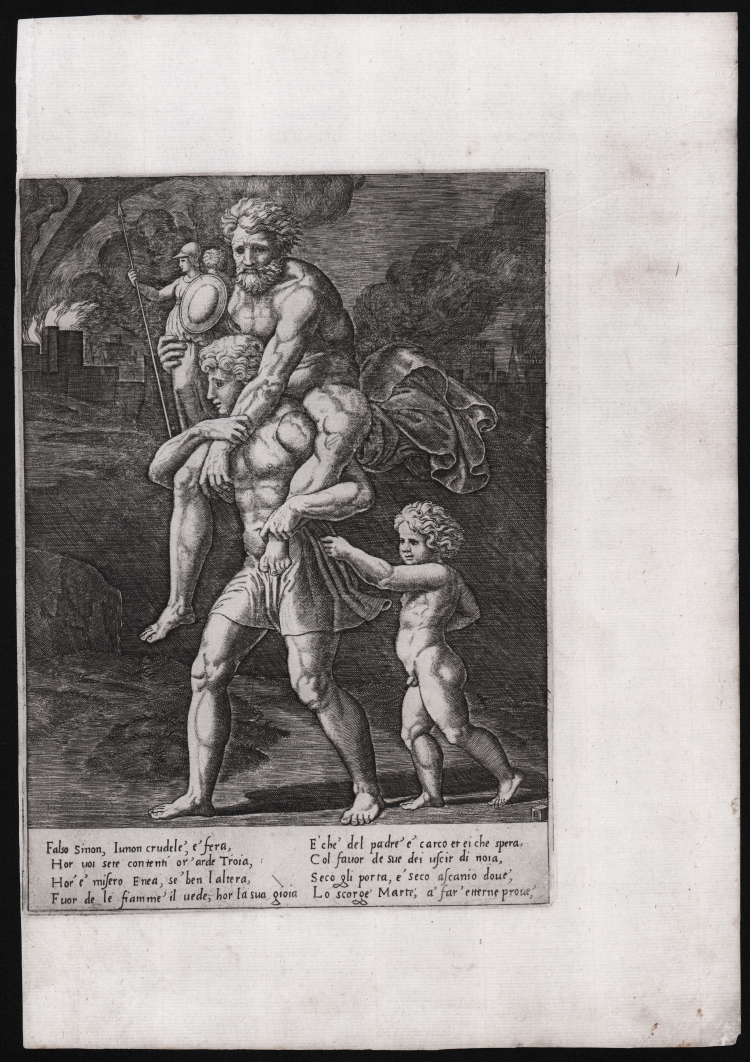





| Reference: | S48425 |
| Author | Maestro B nel Dado |
| Year: | 1530 ca. |
| Measures: | 185 x 255 mm |




| Reference: | S48425 |
| Author | Maestro B nel Dado |
| Year: | 1530 ca. |
| Measures: | 185 x 255 mm |
Aeneas carrying Anchises on his shoulders walking to the left, at lower right is a naked child, in the background Troy burns.
Engraving, circa 1530, lettered with eight lines of description in two blocks in bottom margin 'Falso sinon ...a far etterne prove'. Artist's monogram 'B' on a dice at right.
After Raphael. Example of the early state, before the address of Philippe Thomassin.
A very good impression – possibly printed by Antonio Lafreri workshop – printed on contemporary laid paper without watermark, with large margins on three sides and trimmed to the platemark on the left, very good condition.
The subject is derived from the fresco in Raphael's third Stanza at the Palazzi Apostolici, the Borgo fire, a work created by Sanzio together with some of his most able assistants in 1514 and the first that Raphael completed at the behest of the new pontiff Leo X, who had ascended the Throne of St. Peter in March 1513 to succeed Julius II who died in February of that year. Placed on the left of the fresco, the composition depicts a young man carrying an older man on his shoulders. At his side is a young boy and a woman follows him. He escapes tragedy but does not give up his humanity. It is Aeneas carrying Anchises on his shoulders, his son Ascanius; the woman following him looks away. It is perhaps Creusa, Aeneas' wife, who will be lost in the burning of Troy. Raphael quotes Virgil; it is from a tragedy, from an exodus of a fleeing people, that Rome is born. The Trojan hero flees from a burning city, but he does not lose his humanity. It is from the family, from fathers and mothers, from the cult of ancestors, from pietas that civilization draws its foundation. It springs from the ashes to rise to new life, but it is not barbarism, it is not abandonment of values. As in the myth of Atlas holding the world on his own shoulders, the young son rescues his shabby, old, ailing father and carries him across the waters to the new promised land where he will found Rome. The journey will be long and perilous, the losses severe and irreparable. Aeneas will lose his wife, as in the myth of Orpheus and Eurydice, he will try to descend into Hades to bring her back with him to the realm of the living. His father will die in the new world, in Drepano, ancient Trapani, and his body legend says is on the slopes of Erice where a temple was erected to Aphrodite, the goddess with whom man had conceived the hero Aeneas. But finally fate will lead Aeneas to found the city of Rome from which an empire will be born that will dominate the world through the centuries.
Bibliografia
Bartsch, Le Peintre graveur (XV.224.72); The Illustrated Bartsch, 72, V. 29 P. 228, 1978-1983; Le Blanc C., Manuel de L'amateur d'estampes, 78, V. 2 P. 82; Bernini Pezzini G.- Massari S.- Rodino' S., Raphael Invenit: Stampe da Raffaello nelle Collezioni dell'istituto Nazionale per la Grafica., VI/1, p. 235.
Maestro B nel Dado (Attivo a Roma, metà XVI sec.)
|
Master del Dado was trained as painter and engraver in Marcantonio’s workshop; he was born around 1512 and worked in Rome between 1532 and 1550. He is very often mistaken with Beatricetto or Bonasone.
Le Blanc believes that he was a descendant of Bernardo Daddi (1512 – Rome 1570), a painter, according to the monogram that signs his prints. Some others identify him with Benedetto Verini, presumed son of Marcantonio, which would have explained the monogram BV on his plates. According to Bartsch though, the V might stand for Venetian or again for Tommaso Vincidor da Bologna.
He engraved drawings of other artists for Lafrery; his favourite subjects were Raphael, Peruzzi, Giulio Romano and Tommaso Vincidor.
To Master del Dado have been ascribed about 85 prints, according to Malaspina and also Bartsch says they are 85, while Passavant believes they are 89.
|
Maestro B nel Dado (Attivo a Roma, metà XVI sec.)
|
Master del Dado was trained as painter and engraver in Marcantonio’s workshop; he was born around 1512 and worked in Rome between 1532 and 1550. He is very often mistaken with Beatricetto or Bonasone.
Le Blanc believes that he was a descendant of Bernardo Daddi (1512 – Rome 1570), a painter, according to the monogram that signs his prints. Some others identify him with Benedetto Verini, presumed son of Marcantonio, which would have explained the monogram BV on his plates. According to Bartsch though, the V might stand for Venetian or again for Tommaso Vincidor da Bologna.
He engraved drawings of other artists for Lafrery; his favourite subjects were Raphael, Peruzzi, Giulio Romano and Tommaso Vincidor.
To Master del Dado have been ascribed about 85 prints, according to Malaspina and also Bartsch says they are 85, while Passavant believes they are 89.
|